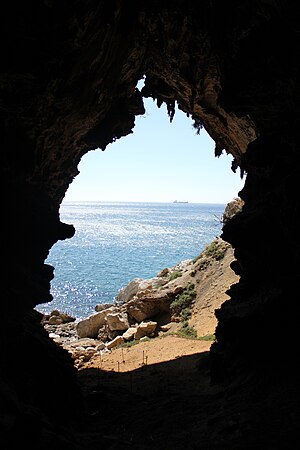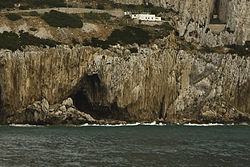Gorham's Cave: Difference between revisions
| Line 63: | Line 63: | ||
{{Caves of Gibraltar}} | {{Caves of Gibraltar}} | ||
[[Category:Prehistoric | [[Category:Prehistoric Gibraltar]] | ||
Latest revision as of 14:28, 14 February 2020
| Gorham’s cave | |
| Gibraltar | |
|---|---|
 View from inside Gorham's Cave | |
| Co-ordinates: | 36°7’13"N, 5°20’31"W |
| Depth: | 59 feet |
| Geology: | Limestone |
Gorham's Cave is a natural sea cave in Gibraltar, puncturing the southeast face of the Rock. The cave is the last recorded place of Neanderthal occupation in the world.
The archaeological significance of the cave was revealed in the 1950s when excavations were carried out: these revealed Neanderthal occupation. Archaeologists found Mousterian stone tools, which had been made by the Neanderthals, along with a wide range of animal bones. Work resumed in 1989, when the Gibraltar Museum teamed up with the British Museum and the Natural History in London to begin the Gibraltar Caves Project, and these excavations in Gorham’s Cave continue.
It is reckoned that when first inhabited, the cave would have been approximately 3 miles from the shore but in the modern age it is found only a few yards from the Mediterranean Sea.
Discovery

The cave is named after Captain A Gorham of the 2nd Battalion Royal Munster Fusiliers who discovered it in 1907 when opening a fissure at the back of a sea cavern. Captain Gorham inscribed his name and the date of his discovery in lamp-black on the wall of the cave which has borne his name ever since. After this initial discovery, it seems the cave was forgotten at least at an official level as Gibraltarian historian and potholer George Palao recalls an inscription on the cave wall that read J. J. Davies 1943.[1]
This important cave is part of a sequence of caves known as the Gorham’s Cave Complex which is currently in the United Kingdom’s Tentative List for inscription as a UNESCO World Heritage Site. .[2]
Cavemen
Gorham’s Cave has a 60-foot deep archaeological sequence that covers the period from about 55 thousand years ago to the third Century BC. The sequence is dominated by Neanderthal occupation right up to 28,000 years ago.
After the last Neanderthals, Gorham’s Cave was occupied by early modern humans between 20,000 and 13,000 years ago. The Palaeolithic sequences are rich in fossils, stone tools and other evidence which is being put together by the Gibraltar Museum to reconstruct the lives of the people who lived in the cave.
Carthage
The top level of Gorham’s Cave was used by Phoenicians or Carthaginians between the 9th and 3rd Centuries BC as a coastal shrine at of the Pillars of Hercules, the end of the world. The ancient mariners left offerings to their gods for safe passage to and from the unknown.
Archaeological investigations
Since its discovery, Gorham's Cave has been a site of considerable [archaeological interest.
Two Royal Engineers, craftsmen Keighley and Ward, were the first to find an archaeological deposit in the cave when the beach leading to Gorham’s Cave (Governor's Beach) became temporarily accessible from the cliffs above by way of a pile of spoil that resulted from tunnelling inside The Rock. Gibraltar newspaper reports of the time report that a quantity of pottery, stone tools (from the Neanderthal period), and some human and animal remains had been unearthed at the cave. The Royal Engineers told Rev F E Brown of the Gibraltar Society of their findings who in turn informed the Governor of Gibraltar, who visited the site and called for further investigations to be carried out. The results of these investigations were detailed in a report sent to the British Museum and the cave was closed pending their advice on the matter.
In 1945, a Lieutenant George Baker Alexander, Royal Engineer and a graduate geologist from University of Cambridge arrived in Gibraltar and, in his own time, conducted a thorough geological survey of Gibraltar which concluded with the production of a new geological map of The Rock. Lt. Alexander became the first to excavate Gorham’s Cave, before his forced departure from Gibraltar in 1948 when the Gibraltar Museum Committee challenged his methods.
In 1948 at the request of the Governor, Dr John D'A Waechter arrived in Gibraltar and spent two months digging test pits. His success brought him back the next year to continue on a larger scale, and he worked, with academnic interruptions, through to his final visit in 1954 when funds ran out.
Ongoing excavation
Excavation of this site has resulted in the discovery of four layers of stratigraphy. The first level has produced evidence for 8th to 3rd centuries BC use by Phoenicians. Below that is evidence for brief Neolithic use. Level III has yielded at least 240 Upper Paleolithic artefacts of Magdalenian and Solutrean origin. Level IV has produced 103 items, including spear-points, knives and scraping devices, identified as Mousterian, and shows repeated use over thousands of years. AMS dating gives dates for this level of between 33- and 23,000 years BP — the researchers felt that the uncertainties at this time depth made calibration impractical. They suggest occupation until at least 28,000 years ago and possibly 24,000 years BP.[3] No fossil remains have been found that would allow identification pointing to either Neanderthal or Anatomically Modern Human inhabitants, nor associate with findings of a modern human in nearby Abrigo do Lagar Velho, Portugal of 24,500 years ago that allegedly featured Neanderthal admixtures,[4] but Mousterian culture is normally identified with Neanderthals in Europe.[5]
The ownership of land associated with Gorham's Cave was passed from the Ministry of Defence to the Government of Gibraltar in 2011 (in a broad landswap agreement for housebuilding).[6]
See also
Outside links
| ("Wikimedia Commons" has material about Gorham's Cave) |
- Alfano S Did Neanderthals Last Longer? CBS News, 13 Sep 2006
- Rock art found in Gorham's Cave in Castillian
- History of Gorham's Cave from Gibraltar Museum website
- Current information on Gorham's Cave from the Gibraltar Museum
- Stringer CB, Finlayson JC, Barton RN, et al.: Neanderthal exploitation of marine mammals in Gibraltar, Proc. Natl. Acad. Sci. USA Vol 105 issue 38 pp 14319–24
References
- ↑ Finlayson, Clive. "History of Gorham's Cave". Gibraltar Museum. http://www.gibmuseum.gi/Gorhams_History.html. Retrieved 5 December 2010.
- ↑ Gorham's Cave Short-Listed, BBC News, 28 May 2012
- ↑ Finlayson C, Pacheco FG, Rodríguez-Vidal J, et al.: Late survival of Neanderthals at the southernmost extreme of Europe (Nature, Vol 443 issue 7113, pp 850–3)
- ↑ Duarte C, Maurício J, Pettitt PB, et al. The early Upper Paleolithic human skeleton from the Abrigo do Lagar Velho (Portugal) and modern human emergence in Iberia (Proc. Natl. Acad. Sci. USA Vol 96 issue 13, pp 7604–9)
- ↑ Location diagrams at Anthropologynet and BBC News
- ↑ "Government announces details of the recent Lands Agreement with MOD". 29 July 2011. Government of Gibraltar. http://www.gibraltar.gov.gi/archives/press-releases-archives/2011/1526-2302011-government-announces-details-of-the-recent-lands-agreement-with-mod-. Retrieved 1 May 2013.
